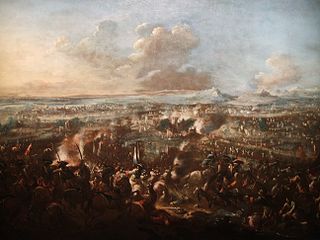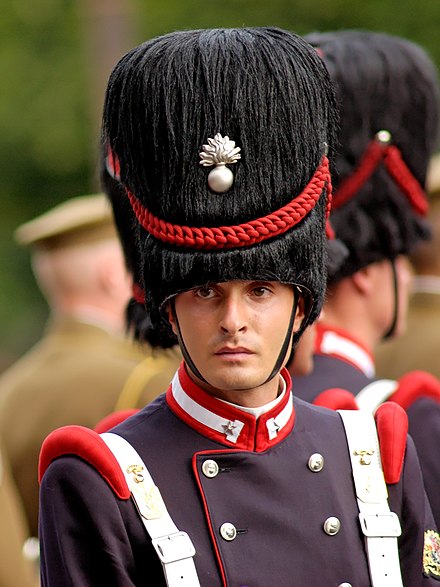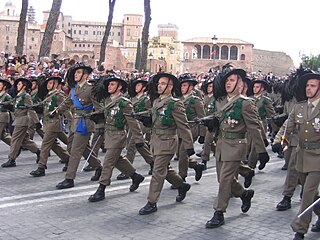
The Bersaglieri, singular Bersagliere, are a special unit of the Italian Army infantry corps. They were originally created by General Alessandro La Marmora on 18 June 1836 to serve in the Army of the Kingdom of Sardinia, later to become the Royal Italian Army. They have always been a high-mobility light infantry unit, and can still be recognized by the distinctive wide brimmed hat that they wear, decorated with black capercaillie feathers. The feathers are usually applied to their combat helmets. Another distinctive trait of the Bersaglieri is the fast jog pace they keep on parades, instead of marching.

The Italian Army is the land-based component of the Italian Armed Forces of the Italian Republic. The army's history dates back to the unification of Italy in the 1850s and 1860s. The army fought in colonial engagements in China, Libya, Northern Italy against the Austro-Hungarian Empire during World War I, Abyssinia before World War II and in World War II in Albania, Balkans, North Africa, USSR and Italy itself. During the Cold War, the army prepared itself to defend against a Warsaw Pact invasion from the east. Since the end of the Cold War, the army has seen extensive peacekeeping service and combat in Afghanistan and Iraq. Its best-known combat vehicles are the Dardo infantry fighting vehicle, the Centauro tank destroyer and the Ariete tank and among its aircraft the Mangusta attack helicopter, recently deployed in UN missions. The headquarters of the Army General Staff are located in Rome opposite the Quirinal Palace, where the president of Italy resides. The army is an all-volunteer force of active-duty personnel.
The article provides an overview of the entire chain of command and organization of the Italian Army after the reform of 1 October 2016 and includes all active units as of 1 July 2019. The Armed Forces of Italy are under the command of the Italian Supreme Defense Council, presided over by the President of the Italian Republic. The Italian Army is commanded by the Chief of the Army General Staff or "Capo di Stato Maggiore dell’Esercito" in Rome.
On March 1, 1984 the Italian Institute for Disarmament, Development and Peace (Istituto di ricerche per il disarmo, lo sviluppo e la pace in Rome published the entire Italian Army order of battle down to company level - this was justified for the radical party as one of its core demands was total disarmament of Europe, even though the data which was published was top secret. The Radical Party dissolved in 1989 and the IRDISP followed suit in 1990. But Radio Radicale has survived, and the OrBat can still be found today on the homepage of the radio.

The Mechanized Brigade "Sassari" is a mechanized infantry brigade of the Italian Army, based on the island of Sardinia. Its core are three infantry regiments which distinguished themselves in combat during World War I. Carrying the name of the Sardinian city of Sassari the brigade's coat of arms is modeled after the city's coat of arms. The brigade is part of the Division "Acqui".

The Pozzuolo del Friuli Cavalry Brigade is a brigade of the Italian Army, based in the Friuli Venezia Giulia and Veneto regions. The Brigade consists of a command unit, a cavalry regiment, an amphibious infantry regiment, an artillery regiment, an engineer regiment and a logistic regiment.

The Aosta Mechanized Brigade is a mechanized infantry brigade of the Italian Army, based on the island of Sicily. The Brigade is one of the oldest of the Italian Army and the name connects the brigade to its original area of recruitment the Aosta Valley and its coat of arms is modeled after Aosta's coat of arms. The brigade is part of the Division "Acqui".

The 131st Armoured Division Centauro was an armoured division of the Italian Army during World War II. It was formed in February 1939, by upgrading the 1st Armoured Brigade. It took part in operations in Albania, Greece and Yugoslavia before returning to Italy. Sent to North Africa in August 1942, it surrendered in Tunisia on 13 May 1943.

The 21st Infantry Division Granatieri di Sardegna was an infantry division of the Italian Army during World War II. The Granatieri di Sardegna Division can trace its origins to 1659 when the Duke Carlo Emanuele II of Savoy formed a regiment of Guards. It became a unit in the national army in 1866.

The Armored Brigade "Centauro" was an armored brigade of the Italian Army. Originally raised in 1975 as 31st Armored Brigade "Curtatone" it changed its name in 1986 when the Armored Division "Centauro" was disbanded. The brigade's headquarters was in the city of Novara and most of its tank and Bersaglieri units were based in the nearby city of Bellinzago Novarese, both located in the Province of Novara. The brigades name comes from the mythological race of half human-half horse creatures named Centaurs.

The Armored Brigade "Vittorio Veneto" was an armored brigade of the Italian Army. Its core units were armored and mechanized cavalry squadrons groups. The brigade's headquarters was in the city of Villa Opicina, with most of its units based in the Province of Trieste. The brigade's name was chosen to remember the decisive Italian World War I victory at the Battle of Vittorio Veneto.

The 132nd Armored Brigade "Ariete" is the only active armored brigade of the Italian Army. Its core units are Tank and Bersaglieri regiments. The brigade's headquarters is in the city of Pordenone. Most of its units are based in the North-East of Italy. The brigade's name comes from the battering ram. The brigade draws much of its historical traditions from the 132nd Armoured Division Ariete, active during the Second World War from 1939-42, and again active from 1948-1986. The brigade is part of the Division "Vittorio Veneto".
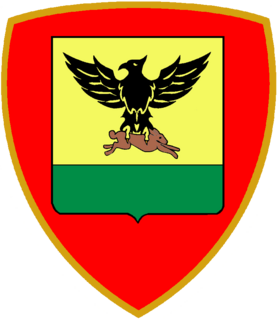
The Motorized Brigade "Acqui" was an infantry brigade of the Italian Army, based in the centre of the Italian peninsula. The brigade's name was one of the oldest of the Italian Army and connected the brigade to its original area of recruitment around the city of Acqui. The brigade was disbanded in 1996, but re-raised as a deployable division command in 2003 and elevated to full division with assigned brigades in 2013.

The Mechanized Brigade "Legnano" was a mechanized brigade of the Italian Army. Its core units were mechanized infantry battalions. The brigade's headquarters was in the city of Bergamo in Lombardy. The name of the brigade commemorates the Lombard League victory in the Battle of Legnano in 1176 and its coat of arms depicts the Monument to the Warrior of Legnano in the centre of Legnano.
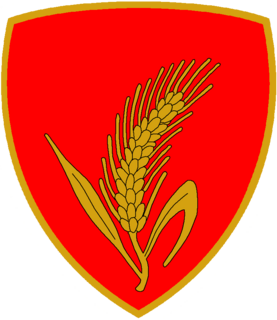
The Motorized Brigade "Cremona" was an infantry brigade of the Italian Army. The brigade's headquarters was in the city of Turin. The brigade carried on the name and traditions of the 44th Infantry Division "Cremona".

The Mechanized Brigade "Trieste" was a mechanized brigade of the Italian Army. Its core units were mechanized infantry battalions. The brigade's headquarter was in the city of Bologna. Named after the North-Eastern city of Trieste the brigade's coat of arms was modeled after the city's coat of arms.

The Folgore Mechanized Division was a mechanized division of the Italian Army. Its core units were three mechanized brigades. The brigades headquarters was in the city of Treviso.
The Order of Battle of the Italian Army at the end of 1989 is given below.
With the 1975 reforms the Italian Army abolished the regimental level and replaced it with brigades made up of multiple arms. During the reform the army disbanded 48 regimental commands and reduced its force by 87 battalions. A further ten regimental commands were used to raise ten new brigade commands. Ten training centers, which for traditional reasons had carried the names of regiments, were also disbanded. The reduction in units also allowed to mechanize most of the remaining units in Northern Italy and Italy's defense strategy changed from a hold-at-all-costs territorial defense to one of mobile warfare.









